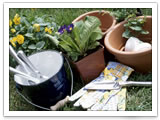
|
Follow Me On: |
 |
Kathleen Petty AVP/Sr Mortgage Originator Global Credit Union Home Loans AK#157293 Phone: (907)261-3458 Cell: 223-4440 Fax: (907)929-6699 License: NMLS Unique Identifier #203077 K.Petty@gcuhome.com https://www.globalcu.org/home-loans/resources/originators/Kathleen-Petty/ |
 | ||
| ||||
March 2007

|
Plant a Spring Garden Improve Your Home and Your Life
If your description includes the words "lush" and "vibrant", or phrases like "thriving" and "full of life", congratulations are in order. Somehow you managed to maintain a great looking yard throughout the winter. On the other hand, if it contains adjectives such as "drab" and "dreary", or clichés like, "in need of a facelift", roll up your sleeves – it's time for an outdoor project. Before you become stressed out about the high costs or amount of work that can accompany an outdoor project, take a deep breath. We're not talking about re-landscaping or changing the entire look of your yard. We're talking about planting a spring garden. Why a Spring Garden? The first reason for planting a spring garden is because... it's spring. Metaphorically speaking, springtime symbolizes a new beginning. This rebirth of sorts lets us know we've survived another winter and have a summer of sunshine, longer days, and outdoor activities in our near future. What a great reason to enhance the aesthetics outside of our front and back doors. Realistically speaking, springtime is ideal for most planting. In terms of a vegetable garden, the optimal seed-sowing time is between April and June. The same is also true for most flowers, as well as flowering trees and shrubs. For plants that may require indoor sowing, prior to a transfer outdoors, February and March are a perfect time to get this accomplished. The next reason to plant a spring garden is it will improve the look of your home. This is especially important for any homeowners looking to sell. YOU Magazine has featured several articles detailing the importance of curb appeal when selling a home. Planting a spring garden is a potentially quick and inexpensive method for accomplishing this objective. Another incentive for trying your hand at gardening is the benefits you'll reap from preparing fresh vegetables out of your garden or decorating your home's interior with fresh-cut flowers. These are not only money savers, but also the "fruits" of your labor, which will serve as constant reminders of the unification of your creativity and hard work. Lastly, gardening is an outdoor activity that can be enjoyed by anyone. It's not only great exercise, it's also the perfect excuse to enjoy a little sunshine and breathe some fresh air. Getting Started If you're not sure what you want when it comes to plant choices and garden design, there are a few things you can do. First, go online and search for gardening websites like www.thegardenhelper.com. Websites of this nature are not only great when it comes to general information, they also have a tendency to inspire creativity. Thegardenhelper.com even has a forum where registered members can post questions for fellow members to answer. Another option is to take pictures of your yard and bring them to a local nursery. Rest assured, someone working there will have great design ideas along with a well-rounded understanding of plant life. What's even better, these local experts will be knowledgeable when it comes to the weather and growing conditions associated with your area. The next step is to test the soil's pH level. "pH" (which stands for potential Hydrogen ions) is the measurement that determines the soil's acidity or alkalinity. This is important because plants need soil conditions that are appropriate to their needs. Some plants are so sensitive that they won't even grow, let alone thrive, in conditions that are less than optimal. Testing your soil's pH level is no big deal. First, check with your local nursery to see if they'll do it for you. This process requires you bringing them a soil sample. If your nursery does not offer this service, they will more than likely sell home testing kits. These kits are nothing more than a test tube that holds the soil sample as well as a testing solution. Add the solution to the soil, shake, and wait the appropriate amount of time, as stated in the instructions. The solution will turn a color that corresponds to a chart of pH levels in the kit's manual. Now that you know what you want to plant, as well as the conditions of your soil, you are halfway there. The next step is to consult either your local nursery or the Internet as to how to adjust the soil in order to make it optimal. The condition of the existing soil, as well as the type of vegetation you're looking to plant, will dictate the appropriate course of action. The good news is that adjusting soil is usually not that difficult. Whether you're planting from seed or transplanting, every type of plant life comes with specific criteria in terms of planting depth, as well as the required space in between plants. Prior to planting, research the criteria using either the Internet, the experts at your local nursery, or both. Once you understand what needs to be done, both in terms of the soil and subsequent planting, it's time to purchase some equipment. For those of you who may be gardening novices, here is a list of some basic equipment you will most likely need:
A Few More Tips Prior to planting your garden, observe your yard throughout the day. Take notes on where and when the sun hits, as well as for how long. This information will be quite helpful as certain plants do better in direct sunlight, while others do better in shade. Potted plants (both outdoor and indoor) typically do better when placed in an area that closest resembles their natural habitat. For example, most cacti do best in direct sunlight and benefit when placed in the sunniest spots of your home. At the same time, many tropical plants do well in warmth and humidity, and can thrive in bathrooms which receive natural light. Do your research on the plants you choose, and place them in the most appropriate spots around your home. Herbs not only do well in backyard gardens but also grow quite nicely when potted and placed on a balcony or deck. They even grow well when planted in window boxes and placed on your windowsill. The point is that no matter where you live or how small a space you have to work with, anyone can have an herb garden. Whatever you do, don't let springtime pass without taking advantage of planting opportunities. A spring garden of any kind will not only enhance your home but may enhance your life as well. Good luck and happy gardening. | ||||||||||||||||||||||||||||||
License #AK157293 You are receiving a complimentary subscription to YOU Magazine as a result of your ongoing business relationship with Kathleen Petty. While beneficial to a wide audience, this information is also commercial in nature and it may contain advertising materials. INVITE A FRIEND to receive YOU Magazine. Please feel free to invite your friends and colleagues to subscribe. SUBSCRIBE to YOU Magazine. If you received this message from a friend, you can subscribe online. UNSUBSCRIBE: If you would like to stop receiving emails from Kathleen Petty, you can easily unsubscribe. Global Credit Union Home Loans AK#157293 |
, 125 W Dimond Blvd #110 Anchorage, AK 99515 Powered by Platinum Marketing © Copyright 2024. Vantage Production, LLC. | |||||||||


